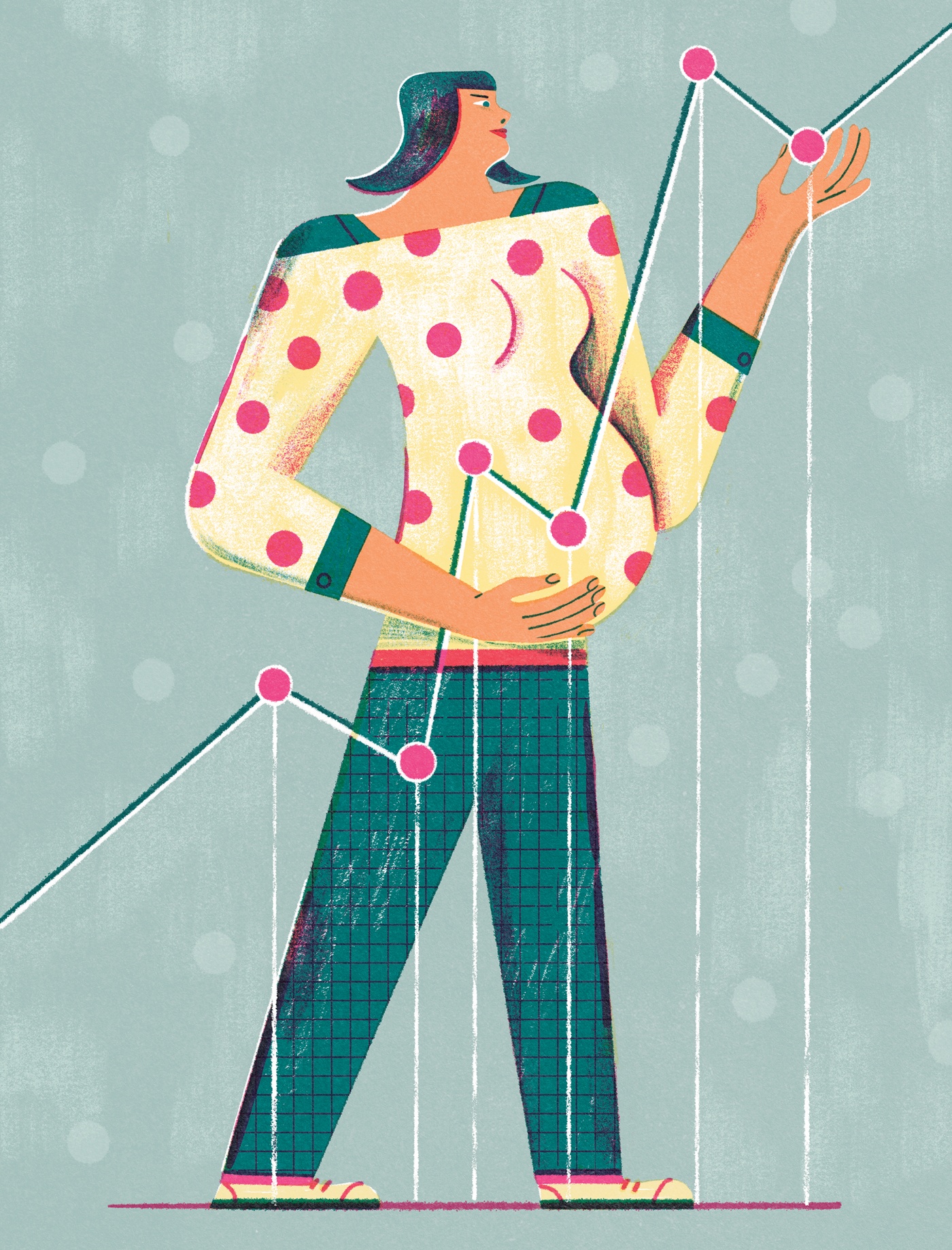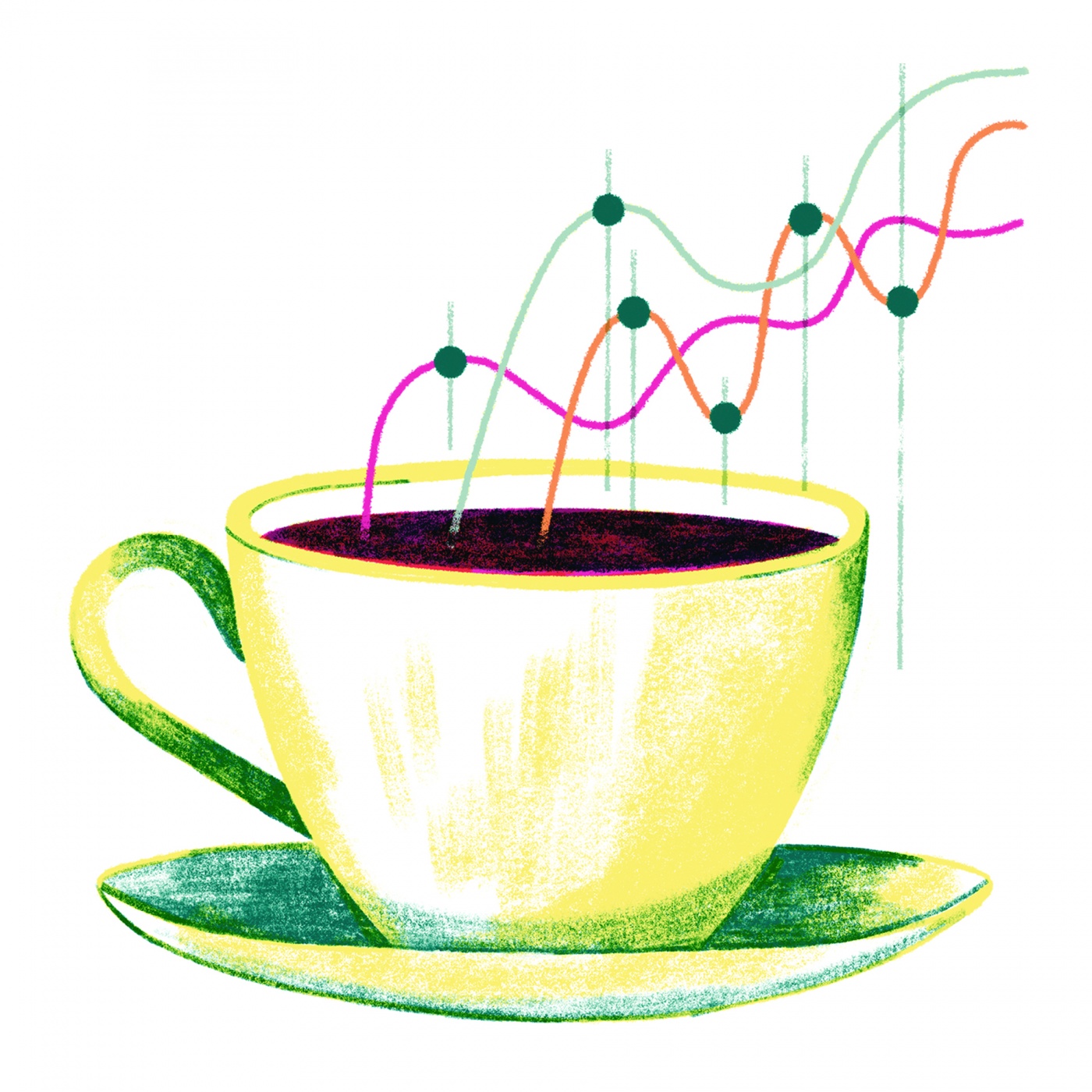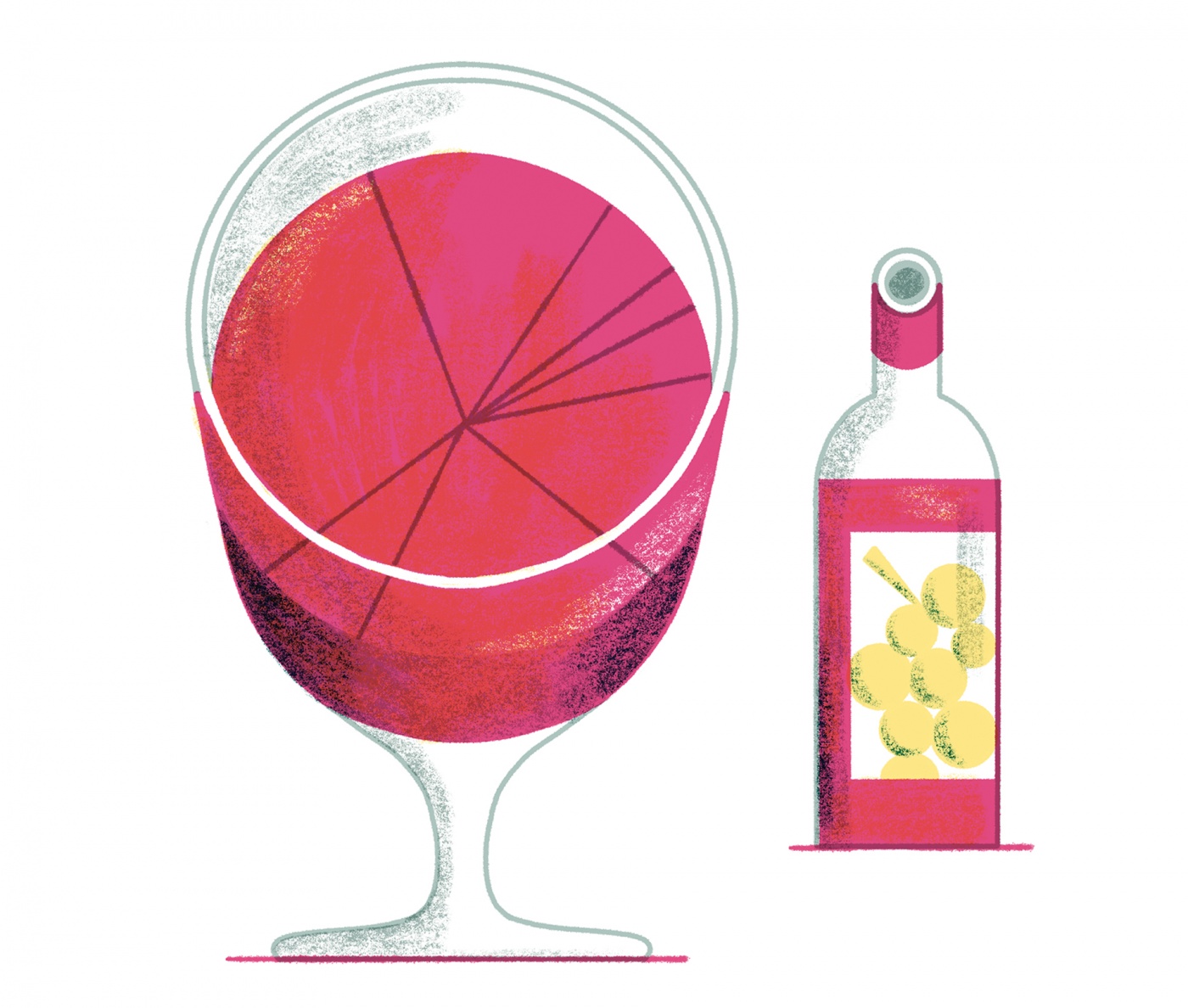Parenting Rules You Can Break
Will a sip of wine hurt your unborn child? Is your toddler going to lose IQ points if you sit them in front of a TV? Brown economist Emily Oster explains why the commonly accepted scientific answers to these questions might be wrong—and encourages parents to relax a little.

Emily Oster, PhD, wants you to think about SpongeBob SquarePants.
Not because the troublemaking yellow sea sponge just celebrated his 20th birthday. And not because there’s a Broadway musical based on his life, featuring original songs by David Bowie, John Legend, and Lady Antebellum. (Although…wow.)
No, Oster, the Royce Family Professor of Teaching Excellence and a professor of economics and international and public affairs at Brown University’s Watson Institute, wants you to consider SpongeBob in the context of an argument pitting correlation against causation as it pertains to weak studies infiltrating the public consciousness, thus altering the shape of public health as we know it.
We’ll get to an explanation of that mouthful. But first, let’s back up a bit.
Good studies, flawed studies
In 2010, when Oster became pregnant with her first child, she found herself in a common maternal predicament: Normally a four-cup-a-day coffee drinker, she wondered if it was safe to indulge in her favorite vice.
Oster’s best friend had been told by her OB to ditch caffeine entirely. The American College of Obstetricians and Gynecologists (ACOG) says consuming fewer than 200 mg of caffeine a day—the equivalent of one 12-ounce cup of coffee—is safe during pregnancy. Online research yielded even more diverging recommendations.
So she dug deeper, examining the medical literature behind these various guidelines. “I realized that part of the reason the recommendations are so different is the literature is really confusing,” she says. “Some studies are really good, but others are subject to certain biases.”
To wit: A number of observational studies have correlated prenatal caffeine intake with miscarriage. This association arose from studies retrospectively comparing pregnant women who drank coffee with those who didn’t. This is called an observational study, in which researchers observe the impact of a risk factor, medical treatment, or other intervention on a group of subjects after they’ve been exposed to it.
The problem with relying on observational data, Oster says, is that all sorts of confounding factors remain unaccounted for, like the fact that “women who drink coffee during pregnancy tend to be older than those who don’t.” If miscarriage is more prevalent among coffee drinkers, “is it because of the coffee…or the age?”
Another confounding factor: Women with morning sickness are less likely to miscarry, perhaps because their nausea is due to fluctuating hormone levels that, while unpleasant for the mom-to-be, reflect ideal fetal conditions. But “most nauseated pregnant women won’t even want to drink coffee,” Oster points out. That means that women who drink a lot of coffee are probably not nauseous, “and they might be more likely to miscarry, regardless of caffeine intake.”
In 2010, when Oster became pregnant with her first child, she found herself in a common maternal predicament: Normally a four-cup-a-day coffee drinker, she wondered if it was safe to indulge in her favorite vice.
A randomized controlled trial (RCT), in which subjects are randomly assigned to a specific treatment or protocol, can help avoid such confusion. In the case of a new medication, for instance, one half receives the new drug and the other half gets a placebo. “The key,” Oster explains, “is that the assigning is random, to make sure the people receiving the drug are as similar as possible in every other dimension as those not receiving it, and the only thing distinguishing them is the treatment.” This enables researchers to draw causal conclusions—taking Drug X improves Condition Y by Z percent—and is why RCTs are considered the gold standard when it comes to reliable studies.
When studying pregnant women, however, RCTs are tricky, if not downright impossible. It would be unethical to, say, instruct some pregnant subjects to throw back 10 cups of coffee or eat a half-pound of deli meat (another frequent no-no among pregnant women) a day, while having others abstain.
Compounding matters, the media tends to cover studies using sensationalistic, clickbait-y headlines that misinterpret or grossly overstate findings. For example, Oster cites a 2011 University of Virginia study that found that fast-paced cartoons like SpongeBob Square- Pants temporarily taxed toddlers’ attention span. Resulting headlines included “Why SpongeBob is a Bad Influence” and “It’s Official: SpongeBob SquarePants Is Making Our Children Stupid.”

Economics IRL
Oster, who earned her BA and PhD from Harvard University in 2002 and 2006, respectively, and was an associate professor at the University of Chicago Booth School of Business prior to arriving at Brown in 2014, had tackled this issue of flawed study design in her own field of economics, where a concept called ceteris paribus—a Latin phrase meaning “all else being equal”—governs the study of cause and effect relationships between variables. While RCTs are common in medical and public health studies (pregnancy aside), they’re not frequently seen in economics. So economists become fluent in an array of statistical techniques that allow them to responsibly handle and effectively tease apart observational data.
This put Oster, now a mother of two (Penelope is 8 years old; son Finn, 4), in a prime position to evaluate and interpret the literature on coffee and miscarriage. After dedicating months to a meta-analysis, she concluded that moderate maternal caffeine intake does not, in fact, hike miscarriage rates.
As a result of her eye-opening, caffeine-approving first-trimester realization, Oster went on to deliver two revelatory books to the pregnant and parenting masses: Expecting Better: Why the Conventional Pregnancy Wisdom Is Wrong—and What You Really Need to Know, published in 2013, and last year’s follow-up, Cribsheet: A Data-Driven Guide to Better, More Relaxed Parenting, from Birth to Preschool. In both, she systematically breaks down the data surrounding the most confusing—and often polarizing—issues confronting pregnant women and new parents, respectively: Prenatal testing, alcohol and medication during pregnancy, epidural safety, breast vs. bottle, childhood vaccinations, screen time, and more. At the end of each chapter is Oster’s bottom line, meant to serve not as advice, but as evidence the reader can use to make her or his own decision.
“It’s not about what you ‘should’ do,” she says, “but about giving people data they can use to make decisions that work for them in the most informed way possible.”
Response to these meticulously annotated labors of love has been tremendous: Cribsheet is a New York Times bestseller. Comedian Amy Schumer told her Instagram followers that Expecting Better “by @profemilyoster got me through pregnancy”; Freakonomics co-author and father of six Steven Levitt has called it “the bible of my circle”; and Slate’s parenting advice columnist likened it to “Xanax in book form.”
Read on to learn about some of Oster’s most relieving, science-backed takeaways.
P.S. She drank the coffee.
The debate: Breast versus bottle
Scores of studies conclude that breastfeeding leads to improved overall pediatric health, higher child IQ, reduced rates of behavioral issues and more. The problem, Oster says, is that most of them are based on “seriously biased data,” as it’s typically wealthy, educated white women who nurse—not a representative sample of the population. Even if researchers use statistical techniques to control for maternal education levels, there’s the fact that IQ has a genetic component, meaning mothers with higher IQs are more likely to raise higher-IQ kids, regardless of whether they get the breast or the bottle.
“It’s not about what you ‘should’ do,” she says, “but about giving people data they can use to make decisions that work for them in the most informed way possible.”
A deep dive into the research turned up just one small-but-strong RCT, the Russian PROBIT trial, which randomized new moms into two groups. In one, breastfeeding was encouraged; in the other, it wasn’t. Breastfed infants were ultimately shown to benefit in two infant health conditions: eczema and diarrhea. What the data didn’t show in the breastfed babies: Lower levels of blood pressure, cavities, behavioral or emotional issues, or hyperactivity; improved maternal-child bonding; increased childhood obesity; or any other differences.
Oster also combed through the existing sibling studies, which compare breastfed and bottle-fed siblings. These aren’t as reliable as RCTs; there’s clearly some reason behind the differing feeding methods and that reason, be it major or minor, can impede the determination of causation. But “it does get around the issue of women who breastfeed being fundamentally different from those who don’t,” Oster says. Here, she found no compelling evidence to suggest breast is best.
Oster’s bottom line: If you enjoy breastfeeding, nurse on! Early-life benefits may include enhanced infant digestion and fewer rashes. But the best, least biased data show that breastfeeding does not improve child IQ, behavior, or overall health.
The debate: Working moms versus stay-at-home moms
Whether you’re a SAHM (stay-at-home mom), a WAHM (work-at-home mom) or, as the son of one of Oster’s friends once described her, a “stay-at-work mom,” one thing’s for sure: There’s a study somewhere telling you you’re doing it wrong, screwing up your kiddo’s development in the process.
As it turns out, evidence solid enough to help any of these career choices win the Mommy Wars is scarce.
First, households electing to have a parent stay home are different from those that don’t, and these differences, independent of that parent staying home or not, are likely to influence outcomes. Second, what your child does while you are at work matters, Oster says. (Nanny, day care, etc.) Finally, working generally means money, opening up “opportunities you and your children wouldn’t have otherwise,” Oster writes in Cribsheet, so it’s “a challenge to separate the impact of income from the impact of parental time.”

Oster found reliable evidence that taking maternity leave bodes well for infant health, decreasing the likelihood of premature birth and lowering infant mortality specifically in children of college-educated and married mothers. (This may be because a mom on maternity leave has more time to care for premature or sick newborns.) But overall, whether a mother works at a traditional job full-time, part-time, or not at all doesn’t seem to have any meaningful effect on kids’ long-term outcomes.
Oster’s bottom line: Take parental leave if you can manage the temporary lack of income. After that, make your decision based on your budget and your personal preferences. (In a candid admission sure to resonate with many working mom readers, Oster admits that while she’s “lucky enough to not have to work,” her ideal “happiness-maximizing allocation is something like eight hours of work and three hours of kids a day.”)
The debate: Young kids and TV time
Thanks to concerns that excess screen time leads to everything from delayed cognitive development to childhood obesity, public health organizations are nearly universal in their screen-related recommendations: None for the youngest among us and limited to no more than one hour for children ages two to five.
But Oster says the link isn’t as straightforward as it seems and wants her readers to know that letting their little ones watch a cartoon for 30 minutes while a parent preps dinner is nothing to be ashamed of.
Yes, a 2005 Journal of the American Medical Association paper found that watching more TV under the age of three reduced test scores by the equivalent of a couple of IQ points. But this was a lot of TV—more than three hours a day, on average. It also wasn’t an RCT, so it’s hard to know if the screen time was to blame, or other factors, like the fact that young kids who watch lots of TV tend to be poorer and more likely to have parents with less education, both of which independently correlate with outcomes like test scores.
The study not only failed to find higher levels of behavioral problems among children born to women who drank alcohol while pregnant, it found that light drinkers were significantly less likely to have children with behavioral issues.
The best causal evidence, Oster believes, comes from a 2008 paper authored by two economists, one of whom happens to be her husband, Jesse Shapiro, Eastman Professor of Political Economy at Brown. Shapiro and a colleague examined data from a 1965 survey of more than 300,000 U.S schoolchildren born between 1948 and 1954, just as television was being introduced to the country. Different cities and markets gained access at different times, meaning students of all backgrounds were exposed to varying amounts of television as preschoolers, regardless of parental age, education, or ethnicity. Oster acknowledges that TV in the ’40s and ’50s was different than today, but those kids enjoyed plenty of unfettered, unjudged time with Howdy Doody. The researchers found “strong evidence against the view that childhood television viewing harms the cognitive or educational development of preschoolers.”
Oster’s bottom line: Watching TV early on will not impact childhood test scores, let alone jeopardize your toddler’s chance of one day attending college. It’s too soon to know the impact of other screens, such as iPads or smartphones. Oster also points out that what happens when a child isn’t watching TV matters, too. A 2019 Atlantic story quotes her as saying that screen-time recommendations “sometimes seem to assume that the alternative to TV is always high-quality engaged time with an adult. If that’s the case, then it may be right that screens are bad. But if the alternative is a grumpy, stressed-out adult who needs a break, the calculus may be different.”

The debate: Alcohol during pregnancy
Concern over Fetal Alcohol Spectrum Disorders (FASD), a grouping of physical abnormalities and/or behavioral, cognitive, and learning difficulties that can manifest in children exposed to alcohol in utero, has long shaped the recommendations of the American Academy of Pediatrics, ACOG, and the Centers for Disease Control and Prevention, all of which state there’s no known safe amount of alcohol during pregnancy. Indeed, the science is solid on heavy drinking—it can result in FASD no matter the mother’s age, where she lives, how much she earns, etc.
But Oster was specifically interested in light drinking, maybe a glass of wine at the end of a long, tiring day, a few days a week. Ethical issues prohibit RCTs, so she homed in on studies where the groups of subjects were not all that different apart from alcohol consumption, which “helps reassure us that it’s the alcohol, not the women themselves—their education, socioeconomic status—responsible for any increased rates of behavioral problems,” she explains.
One such study, called a prospective cohort study, followed 2,900 women, gathering data on their drinking when they hit 18 and 34 weeks’ gestation and tracking their offspring for 14 years. Because they were asked to describe their alcohol use as it was happening, their recall was likely more accurate than what one might see in a traditional retrospective study. Also, it was conducted in Australia, where “occasional drinking during pregnancy is not judged as harshly as it is in the U.S.,” Oster says, rendering it less likely that variation in drinking habits reflects variation in other confounding behaviors and characteristics.
That study not only failed to find higher levels of behavioral problems among children born to women who drank alcohol while pregnant compared with teetotalers, it found that light drinkers (those who consumed two to six drinks per week) were significantly less likely to have children with behavioral issues (about nine percent vs. 11 percent for non-drinkers). Other papers with excellent study design revealed similarly reassuring findings.
Additionally, Oster debunked an oft-cited Pediatrics study that linked a daily drink with aggressive childhood behavior. “What wasn’t reported in most media coverage of this study,” she says: Nearly half of the women who had a drink a day also reported cocaine use during pregnancy, as did 18 percent of the nondrinkers. “Maybe the problem is that cocaine makes a child more likely to have behavior problems, not light drinking.”
Oster’s bottom line: After scouring roughly 200 studies on the hotly contested topic, Oster found no credible evidence that an occasional alcoholic beverage has any consequences, and in fact, “more than the occasional drink is likely perfectly fine, too.” Specifically, one to two drinks a week in the first trimester, and up to a drink a day in the second and third trimester, is likely safe, Oster says. (A standard drink includes a 12-ounce beer; 5 ounces of wine; or 1.5 ounce of hard liquor.)
Leslie Goldman is a health writer and author based in Chicago. She holds a master’s in public health from University of Illinois–Chicago.





